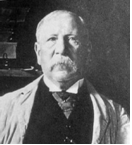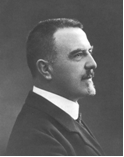1908 - 1910
- 1905
-
D.E. Smith is the first to suggest that an international Commission should be set up to study problems pertaining
to mathematics teaching:
J'estime que la meilleure manière de renforcer l'organisation de l'enseignement des
mathématiques pures serait de créer une commission qui serait nommée par un Congrès international
et qui étudierait le probléme dans son ensemble. (EM, I.7, 1905, p. 469)
- 1908
- During the IV International Congress of Mathematicians (Rome 6-11.4.908), the
Session Number Four on Philosophical, Historical and Didactic
Issues, is
particularly rich and in the meeting of 11 April, albeit with some difficulties, approves the following motion for the constitution of an International Commission on the Teaching of
Mathematics
(Commission Internationale de l'Enseignement Mathématique, Internationale Mathematische
Unterrichtskommission, Commissione Internazionale dell'insegnamento matematico) (Cf.
Atti del IV Congresso Internazionale dei Matematici - Roma, 6-11 aprile 1908, ed. G. Castelnuovo,
Accademia R. dei Lincei, 3 vols. Roma 1909, I, 45, 51,
III, pp. 476-477):
Session Number Four, having recognised the need for a comparative study of the syllabi and teaching
methods of secondary schools across various nations, assigns the task of forming an international Commission,
which would study the issue in question and present its findings at the next Congress, to Professors Klein,
Greenhill and H. Fehr. (Atti, I, 51)
The three mathematicians designated by the Congress constitute the Central Committee:
President: F. Klein
Vice-President: G. Greenhill
Secretary General: G. Fehr

|

|

|
|
Felix Klein |
George Greenhill |
Henri Fehr |
They meet in Cologne (20-23 September 1908) in order to decide upon how the commission is to be organised and to draw up
their agenda (Cf. Rapport préliminaire sur l'organisation de
la Commission, et EM 10, 1908, pp. 445-458).
The Commission is made up of delegates from countries which have participated in at least 2 International Congress
of Mathematicians with an average of at least two members:
Germany, Austria, Belgium, Denmark, Spain, the USA, France, Greece, Holland, Hungary,
the British Isles, Italy, Norway, Portugal, Romania, Russia, Sweden and Switzerland.
These are joined by a number of "associated countries", whose delegates are permitted to follow the activities
of the Commission, without having the right to vote:
Argentina, Australia, Brasil, Bulgaria, Canada, Chile, China, the Cape Colonies, Egypt,
the Indian Raj, Japan (see 1911), Mexico, Peru, Serbia and Turkey.
The Commission is directed by a Central Committee, made up of the three members assigned the role at the Fourth
International Congress of Mathematicians.
These three are responsible for organising the Commission work and publishing its reports.
The international journal L'Enseignement Mathématique is the official publication
of the Commission. The first issue in 1909 already bears the inscription: Organe officiel de la Commission internationale de L'Enseignement mathématique.
The official languages of both the publication and the meetings are those admitted at the International Congresses of Mathematicians:
German, English, French and Italian.
Commission defines its first priority in the following terms: "Make an inquiry and publish a general report on the current trends in the teaching of mathematics in various countries" (EM 10, 1908, 450) bearing in mind not only secondary schools but all kinds and levels of schooling.
The general outline for the work was as follows:
- Current situation of the organization and of the methods of mathematical instruction
- The various kinds of schools
- Aim of mathematics instruction and branches of mathematics taught in the various kinds of schools
- Exams
- Teaching methods
- The training of prospective teachers
- Modern trends in the teaching of mathematics relative to the points listed above
(pp. 452-458)
- 1909
- The delegates of 16 of the 18 countries to be represented on the Commission are appointed at a meeting in Carlsruhe
(5-6/4/1909), (Cf. Circulaire du Comité central n. 1,
EM 11, 1909, 193-204).
GERMANY: F. Klein (University, Göttingen), P. Staeckel (Polythecnic, Carlsruhe), P. Treutlein (Secondary school, Carlsruhe)
AUSTRIA: E. Czuber (Polytechnic, Vienna), R. Suppantschitsch (Secondary school, Vienna), W. Wirtinger (University, Vienna)
BELGIUM: -
DENMARK: P. Heegaard (Associate Inspector for mathematics in secondary schools)
SPAIN: Z. G. De Galdeano (University, Saragozza)
THE USA: D. E. Smith (Columbia University, New York), W. Osgood (Harvard University, Cambridge), J. W. Young (University, Chicago)
FRANCE: A. de Saint Germain (University, Caen), C. Bourlet (Conservatoire des Arts et Métiers, Paris), C. A. Laisant (Polytechnic, Paris)
GREECE: C. Stephanos (University, Athens)
HOLLAND: J Cardinaal (Polytechnic, Delft)
HUNGARY: E. Beke (University, Budapest), G. Rados (Polytechnic, Budapest), L. Ràtz (Secondary school, Budapest)
THE BRITISH ISLES: G. Greenhill (College, Woolwich)
ITALY: G. Castelnuovo (University, Rome), F. Enriques (University, Bologna) G. Vailati (Technical secondary school, Florence)
NORWAY: M. O. Alfsen (Secondary School, Christiania)
PORTUGAL: G. Teixeira (Polytechnic, Porto)
ROMANIA: G. Tzitzeica (University, Bucharest)
RUSSIA: N. Sonin (Ministry of Education, St. Petersburg), B. Kojalovic (Polytechnic, St. Petersburg), K.W. Vogt (Secondary School, St. Petersburg)
SWEDEN: H. von Koch (Polytechnic, Stockholm)
SWITZERLAND: H. Fehr (University, Geneva), C.F. Geiser (Polytechnic, Zurich), J. H. Graf (University, Berne)
The sub-committees of the various countries, made up of representatives for mathematics teaching in various different kinds of schools, including professional institutions, are appointed.
- 1910
- At a meeting held in Basel (28/12/1909) J. Neuberg (University, Liege) is appointed delegate for Belgium, G. Scorza replaced Vailati, deceased, as delegate for Italy. This meeting also sees the appointment of delegates for a number of the associated countries, the establishment of the national sub-committees and a report detailing progress made so far. (Cf. Circulaire du Comité central n. 2, EM 12, 1910, 124-139).
- 10-16th August 1910 - Brussels Meeting
- The International Commission on the Teaching of Mathematics meets in Brussels during the Universal Exhibition. The minutes are published by Fehr
(Cf. Circulaire n. 3, Compte rendu des
séances de la Commission et des conférences sur l'enseignement scientifique et sur l'enseignement technique moyen,
EM 12, 1910, 353-415). The document is divided
up into four sections. The first is dedicated to the activities of the International Commission on the Teaching of Mathematics. The second deals with mathematics
instruction in Germany. The third treats of secondary technical education in France. The fourth section is a report
on the Congrés international de l'enseignement moyen.(15-16/8/1910)
During this meeting the activities of the various member states are presented The work being carried out by the German sub-committee is particularly striking. This group plans to bring out two series of publications. The Berichte und Mitteilungen, edited by the secretary of the subcommission W. Lietzmann, would bring together general information and brief reports. The Abhandlungen über den mathematischen Unterricht in Deutschland, published under Klein's direction, would consist in not only monographs on mathematics teaching in different types of school but also in texts on more general didactic issues, such as those dealt with in a series of five volumes on the following themes:
- Secondary schools in Northern Germany
- Secondary schools in Central and Southern Germany
- General issues relating to mathematics teaching
- Mathematics in technical schools
- Primary teaching
Of these publications, two issues of Berichte and 7 Abhandlungen monographs are already in print at this time.
C. Bourlet holds the general conference,
La pénétration réciproque des mathématiques pures et des mathématiques appliquées dans l'enseignement
secondaire (
EM 12, 1910, 372-387).
The Verein zur Förderung des mathematischen und naturwissenschaftlichen Unterrichts
organises a number of lectures with the patronage of the Prussian Ministry for Education.
Among these, the presentations given by P. Treutlein
and F. Klein are of particular note. Treutlein discusses use of geometric
models in secondary teaching, with a view to helping pupils develop geometric intuition. Klein, after presenting
works already published in Germany as part of International Commission on the Teaching of Mathematics initiatives, talks about the use of the Brill and Schilling models
in the teaching of advanced mathematics.
The lectures on technical teaching in France are accompanied by visits to French exhibitions on aviation, technical teaching, electricity and automobiles.
Livia Giacardi
March 2008
 The website is in construction. New files will be uploaded as soon as they are available.
The website is in construction. New files will be uploaded as soon as they are available.




 The work being carried out by the German sub-committee is particularly striking. This group plans to bring out two series of publications. The Berichte und Mitteilungen, edited by the secretary of the subcommission W. Lietzmann, would bring together general information and brief reports. The Abhandlungen über den mathematischen Unterricht in Deutschland, published under Klein's direction, would consist in not only monographs on mathematics teaching in different types of school but also in texts on more general didactic issues, such as those dealt with in a series of five volumes on the following themes:
The work being carried out by the German sub-committee is particularly striking. This group plans to bring out two series of publications. The Berichte und Mitteilungen, edited by the secretary of the subcommission W. Lietzmann, would bring together general information and brief reports. The Abhandlungen über den mathematischen Unterricht in Deutschland, published under Klein's direction, would consist in not only monographs on mathematics teaching in different types of school but also in texts on more general didactic issues, such as those dealt with in a series of five volumes on the following themes:
 The lectures on technical teaching in France are accompanied by visits to French exhibitions on aviation, technical teaching, electricity and automobiles.
The lectures on technical teaching in France are accompanied by visits to French exhibitions on aviation, technical teaching, electricity and automobiles.
